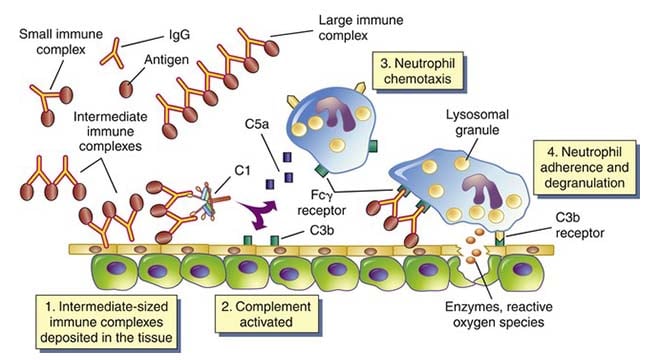- The term hypersensitivity denotes a condition in which an exaggerated immune response of a host results in inappropriate reactions that leads to destruction of host tissues.
- According to the most widely accepted classification of Gell and Coombs, there are four main types of hypersensitivity reactions as type I, II, III and IV.
- Type I, II and III are immunoglobulin-mediated (immediate) hypersensitivity reactions while type IV reaction is lymphoid cell-mediated or simply cell mediated hypersensitivity (delayed-type).
- Type III hypersensitivity reaction also known as immune complex hypersensitivity is the antigen-antibody complex mediated destruction of cells.

- When antibody combines with its specific antigen, immune complexes are formed.
- Normally, they are promptly removed, but occasionally, they persist mostly due to their small size and are deposited in tissues resulting into several disorders.
- Such complexes are more commonly found to be deposited in joints, kidneys and blood vessels causing arthiritis, nephritis and vasculitis respectively while less commonly on other organs leading to organ dysfunction.
- Wherever immune complexes are deposited, they activate the complement system, and macrophage and neutrophils are attracted to the site, where they cause inflammation leading to tissue injury.
- Type III hypersensitivity is primarily mediated by antibodies of the IgG and IgM classes which combine with soluble antigen that are not bound to cell surfaces. The antigens may be self or foreign (i.e., microbial). Tissue damage is caused mainly by complement activation and release of lytic enzymes from neutrophils.
- The reaction can take hours, days, or even weeks to develop, depending on whether or not there is immunological memory of the precipitating antigen. The response can also become chronic, particularly in autoimmune reactions, where antigen persists.
- Type III hypersensitivity as in other cases of hypersensitivity occur when the mechanism of self tolerance is breached and some self reactive immune cells are activated to mount reactions against auto antigens such as the DNA from an auto cell.
Interesting Science Videos
Mechanism of Type III (Immune Complex) Hypersensitivity
- In type III hypersensitivity, antibodies bind to antigens to form immune complexes in the circulation. These complexes travel through the blood stream and get deposited in various susceptible tissues.
- There are two major forms of immune complex-mediated hypersensitivity :
Local Immune Complex Disease or Arthus Reaction:
The immune complexes are formed locally that is directly in the tissues mostly seen in the skin and pulmonary diseases resulting from inhaled antigen.
Systemic Immune Complex Disease:
Systemic disease occurs when soluble antigens combine with antibodies in the vascular compartment, forming circulating immune complexes that are trapped nonspecifically in the vascular beds of various organs. Antibody complexes with microbial or autoantigens resulting in immune complexes.
For instance, clinical disease such as serum sickness or systemic lupus erythematosus with vasculitis and glomerulonephritis.
The mechanism of both the types can be summarized as follows:
- Antigen-antibody complexes are formed when antibodies bind to antigens.
- Incase the complex is not cleared by normal process of phagocytosis, the immune complexes persist in the circulation.
- The immune complexes subsequently deposit in tissues.
- The tissue deposited complexes activate the classical complement cascade.
- The complement fragments (e.g. C3a and C5a) that form during complement activation activate a variety of potent mediators of inflammation causing an influx of neutrophils and monocytes to the site of deposition.
- The attracted neutrophils attempt to engulf the immune complexes. Since the complexes are deposited over the tissues, the neutrophils do not succeed.
- Consequently, the neutrophils release a number of substances like prostaglandins, lysosomal enzymes, and free oxygen radicals over the complexes causing damage to the tissues at the site of immune complex deposition.
- Additionally, the binding of the Fc region of antibody in the immune complex may bind to the Fc receptor on platelets causing aggregation, blood clots and blockage of blood vessels leading to hemorrhages at the site.
Examples of Type III (Immune Complex) Hypersensitivity
- Systemic Lupus Erythematosus : Antibodies are made that bind to certain nuclear antigens which deposit mainly in the kidneys, skin, and joints.
- Post-streptococcal Glomerulonephritis: While fighting a Streptococcal infection, the patient makes antibody that reacts against the pathogen but also cross-react with glomerular antigen which cause antigen-antibody complexes to lodge on glomerular membrane.
- Drug Induced Serum Sickness: Since most drugs are poor immunogens, they act as a hapten by combining with tissue protein in the host and induce immune responses against the drug-host protein complex.
- Farmer’s Lung and Bird fancier’s disease: Pulmonary diseases resulting from inhalation of bacterial spores and avian serum/fecal proteins respectively.
References
- Brooks, G. F., Jawetz, E., Melnick, J. L., & Adelberg, E. A. (2010). Jawetz, Melnick, & Adelberg’s medical microbiology. New York: McGraw Hill Medical.
- Kristine, K. (2009, September 23). Real examples of hypersensitivity reactions. Retrieved from https://www.pathologystudent.com/real-examples-of-hypersensitivity-reactions
- Lydyard, P.M., Whelan,A.,& Fanger,M.W. (2005).Immunology (2 ed.).London: BIOS Scientific Publishers.
- Owen, J. A., Punt, J., & Stranford, S. A. (2013). Kuby Immunology (7 ed.). New York: W.H. Freeman and Company.
- S, S. Type III Hypersensitivity and its Mechanism | Human Immunology. Retrieved from http://www.yourarticlelibrary.com/immunology/type-iii-hypersensitivity-and-its-mechanism-human-immunology/28081

I suffer from type 111 immune complex, ( 12 years ). The prime trigger in my case is magnesium stearate, the most common excipient used in pharmacy, the more drugs prescribed by the doctors to ‘help’ my symptoms the more ill I became! approx 95% of all tablets/capsules contain it. Point of Interest, magnesium stearate has never been proven safe for human consumption, the WHO only instigated trials in 2015.